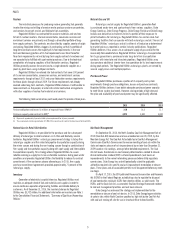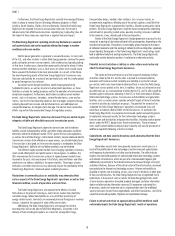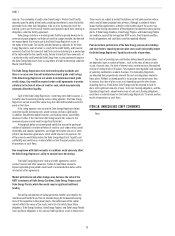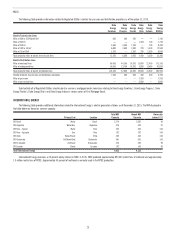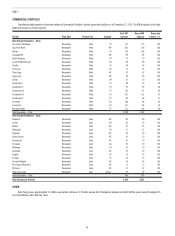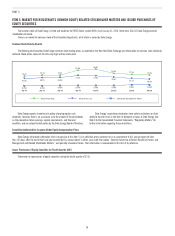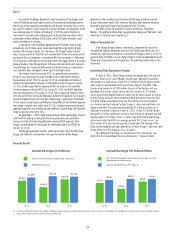Duke Energy 2015 Annual Report Download - page 39
Download and view the complete annual report
Please find page 39 of the 2015 Duke Energy annual report below. You can navigate through the pages in the report by either clicking on the pages listed below, or by using the keyword search tool below to find specific information within the annual report.
PART I
19
Certain events, such as an aging workforce, mismatch of skill set or
complement to future needs, or unavailability of contract resources may
lead to operating challenges and increased costs. The challenges include
lack of resources, loss of knowledge base and the lengthy time required
for skill development. In this case, costs, including costs for contractors to
replace employees, productivity costs and safety costs, may rise. Failure to
hire and adequately train replacement employees, including the transfer of
significant internal historical knowledge and expertise to new employees, or
future availability and cost of contract labor may adversely affect the ability to
manage and operate the business, especially considering the workforce needs
associated with nuclear generation facilities and new skills required to operate a
modernized, technology-enabled power grid. If the Duke Energy Registrants are
unable to successfully attract and retain an appropriately qualified workforce,
their financial position or results of operations could be negatively affected.
Duke Energy’s investments and projects located outside of the U.S. expose
it to risks related to fluctuations in currency rates. These risks, and Duke
Energy’s activities to mitigate such risks, may adversely affect its cash
flows and results of operations.
Duke Energy’s operations and investments outside the U.S. expose it to
risks related to fluctuations in currency rates. As each local currency’s value
changes relative to the U.S. dollar, the value in U.S. dollars of Duke Energy’s
assets and liabilities in such locality and the cash flows generated in such
locality, expressed in U.S. dollars, also change. Duke Energy’s primary foreign
currency rate exposure is to the Brazilian real.
Duke Energy selectively mitigates some risks associated with foreign
currency fluctuations by, among other things, indexing contracts to the U.S.
dollar and/or local inflation rates, hedging through debt denominated or issued
in the foreign currency and hedging through foreign currency derivatives. These
efforts, however, may not be effective and, in some cases, may expose Duke
Energy to other risks that could negatively affect its cash flows and results of
operations.
The costs of retiring Duke Energy Florida’s Crystal River Unit 3 could prove
to be more extensive than is currently identified.
Costs to retire and decommission the plant could exceed estimates and,
if not recoverable through the regulatory process, could adversely affect Duke
Energy’s, Progress Energy’s and Duke Energy Florida’s financial condition,
results of operations and cash flows.
Duke Energy Ohio’s and Duke Energy Indiana’s membership in an RTO
presents risks that could have a material adverse effect on their results of
operations, financial condition and cash flows.
The rules governing the various regional power markets may change,
which could affect Duke Energy Ohio’s and Duke Energy Indiana’s costs and/
or revenues. To the degree Duke Energy Ohio and Duke Energy Indiana incur
significant additional fees and increased costs to participate in an RTO, their
results of operations may be impacted. Duke Energy Ohio and Duke Energy
Indiana may be allocated a portion of the cost of transmission facilities built
by others due to changes in RTO transmission rate design. Duke Energy Ohio
and Duke Energy Indiana may be required to expand their transmission system
according to decisions made by an RTO rather than their own internal planning
process. While RTO transmission rates were initially designed to be revenue
neutral, various proposals and proceedings currently taking place by the FERC
may cause transmission rates to change from time to time. In addition, RTOs
have been developing rules associated with the allocation and methodology
of assigning costs associated with improved transmission reliability, reduced
transmission congestion and firm transmission rights that may have a financial
impact on Duke Energy Ohio and Duke Energy Indiana.
As members of an RTO, Duke Energy Ohio and Duke Energy Indiana
are subject to certain additional risks, including those associated with the
allocation among RTO members, of losses caused by unreimbursed defaults
of other participants in the RTO markets and those associated with complaint
cases filed against an RTO that may seek refunds of revenues previously
earned by RTO members.
NUCLEAR GENERATION RISKS
Duke Energy Carolinas, Duke Energy Progress and Duke Energy Florida
may incur substantial costs and liabilities due to their ownership and
operation of nuclear generating facilities.
Ownership interest in and operation of nuclear stations by Duke Energy
Carolinas, Duke Energy Progress and Duke Energy Florida subject them to
various risks. These risks include, among other things: the potential harmful
effects on the environment and human health resulting from the operation
of nuclear facilities and the storage, handling and disposal of radioactive
materials; limitations on the amounts and types of insurance commercially
available to cover losses that might arise in connection with nuclear operations;
and uncertainties with respect to the technological and financial aspects of
decommissioning nuclear plants at the end of their licensed lives.
Ownership and operation of nuclear generation facilities requires
compliance with licensing and safety-related requirements imposed by the NRC.
In the event of non-compliance, the NRC may increase regulatory oversight,
impose fines, and/or shut down a unit, depending upon its assessment of the
severity of the situation. Revised security and safety requirements promulgated
by the NRC, which could be prompted by, among other things, events within
or outside of the control of Duke Energy Carolinas, Duke Energy Progress and
Duke Energy Florida, such as a serious nuclear incident at a facility owned
by a third party, could necessitate substantial capital and other expenditures,
as well as assessments to cover third-party losses. In addition, if a serious
nuclear incident were to occur, it could have a material adverse effect on the
results of operations and financial condition and reputation of the Duke Energy
Registrants.
LIQUIDITY, CAPITAL REQUIREMENTS AND COMMON STOCK RISKS
The Duke Energy Registrants rely on access to short-term borrowings and
longer-term capital markets to finance their capital requirements and
support their liquidity needs. Access to those markets can be adversely
affected by a number of conditions, many of which are beyond the Duke
Energy Registrants’ control.
The Duke Energy Registrants’ businesses are to a large degree financed
through issuances of debt. The maturity and repayment profile of debt used to
finance investments often does not correlate to cash flows from their assets.
Accordingly, as a source of liquidity for capital requirements not satisfied
by the cash flow from their operations and to fund investments originally
financed through debt instruments with disparate maturities, the Duke Energy
Registrants rely on access to short-term money markets as well as longer-term
capital markets. The Subsidiary Registrants also rely on access to short-term
intercompany borrowings. If the Duke Energy Registrants are not able to access
capital at competitive rates or at all, the ability to finance their operations and
implement their strategy and business plan as scheduled could be adversely
affected. An inability to access capital may limit the Duke Energy Registrants’
ability to pursue improvements or acquisitions that they may otherwise rely on for
future growth.
Market disruptions may increase the cost of borrowing or adversely
affect the ability to access one or more financial markets. Such disruptions
could include: economic downturns, the bankruptcy of an unrelated energy
company, capital market conditions generally, market prices for electricity and
gas, actual or threatened terrorist attacks, or the overall health of the energy


